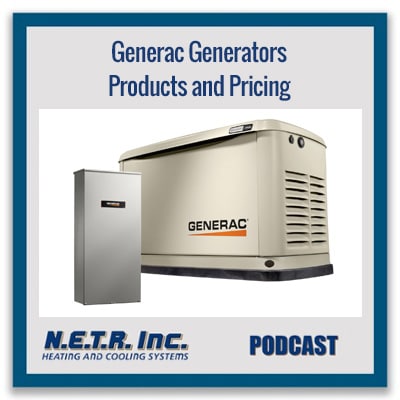
In this podcast, Brett Rogenski from N.E.T.R., Inc talks about Generac generators. He explains the difference between portable and permanent generators, and then, he talks about the different capacities of generators. To learn more, contact N.E.T.R. today.
John McDougall: Hey, this is John McDougall with Brett Rogenski of N.E.T.R., Inc and we’re going to be talking about trends in generators and Generac generators. So welcome, Brett.
Brett Rogenski: Hey, thanks a lot for having me, John.
Trends Driving Adoption Rates of Home Generators
John: Yeah, good. And so, what are the big trends driving this increased interest in generators?
Brett: So, that’s a great question. We recently got some market information from our partners at Generac Generators, and there’s really three big trends that seem to be driving the adoption of generators with homeowners. And the first one is climate change. And you go, gosh, what do you mean climate change? Well, the storm of the century is now really the storm of the year.
So with climate change, we’re seeing a lot more volatile weather conditions as change is imminent, and that’s leading to more power outages because of more violent and frequent coastal storms. Even polar vortex is coming down out of the arctic and stuff. So one of the big trends is, again, that climate change leading to the storm of the century now being the storm of the year.
The second one is the electrification of everything. So we all know, and especially those of you who live in Massachusetts here, that there’s a lot of subsidies and rebates and stuff to drive heating and cooling systems towards electrification. So our heating systems are electric, our cooling systems are electric. Of course, all of our appliances in our home are electric. And guess what? None of that works without power. So when we do have issues with the power grid for whatever the source is, suddenly you can’t heat your home, you can’t cool your home, you’ve lost all your comfort in your home. Plus, your appliances, your refrigerator, your freezer, all those things are now not working as well. So obviously a whole home generator is going to protect all of those things, and not just protect those investments, but also give you comfort, you and your family at home.
And then the last big shift was shifting lifestyles. And that really has gone on over the last three years or so with the COVID-19 pandemic. So we spend much more time at home. We work from home, sometimes permanently, sometimes partially, but all of us spend much more time at home and not out in the workplace. We entertain at home, we spend less time in restaurants and out and traveling. So we’re home a lot more. So that shifting demographic in terms of lifestyle has led to, again, a tremendous rise in the inconvenience and true challenges for people when they do not have power at home. So it’s not like the power was out for a few hours and they’re gone to work and they never noticed. The power’s out now, they can’t work, they’re hot, they’re cold, they’re whatever their situation is, and it’s really impactful.
Models of Generac Generators
John: Yeah. And what are some of the key models of Generac generators that you like?
Brett: There’s absolutely an option for everyone’s needs. So there’s a whole variety. I would tell you, in my mind, there are four models that are probably the most common that can serve most people’s needs. So at N.E.T.R we offer a turnkey service. We sell and provide the generator, we do all the necessary electrical, and we also do all the necessary gas fitting.
And we do the electrical and gas fitting with a licensed plumber and a licensed electrician as well, so everything we do is turnkey. So on the lower end, I would say a 14 kilowatt generator with a 100 amp auto switch that automatically connects and starts the generator when the power goes out, on the low end that’s probably one of our most popular ones that meets most people’s needs in their homes.
And we get a lot of questions about, “Well, geez, what’s that going to cost me?” Well, there’s a lot of different ways to acquire those. I would tell you that you can get into a 14 kilowatt generator done for a turnkey price for about $170 a month, as low as $170 a month. The next step up would be an 18 kilowatt generator with a 100 amp auto switch, and that would be about $195 a month for a payment. Now, we take-
Monthly Payments for Generator Installation
John: That’s not a big increase.
Brett: No, it’s not. You’re at 25 more dollars to really pick up a lot more capability. The next step, and this one’s very common, is a 22 kilowatt generator with a 200 amp service switch. So a 200 amp auto switch. And we put those in, again, turnkey for people with payments as low as $225 a month. And then the final, which is, if you will, the big daddy, very few people need anything larger than this, is a 24 kilowatt generator with a 200 amp auto switch. And again, done with a typical gas fitting and typical electrical needs, that can be as low as $245 a month. So there’s a lot of great options out there. Of course, there’s others. We always say typical gas and typical electric. Occasionally someone needs something, some jobs are easier, some jobs are a little more difficult. But those are great budgetary prices for people.
Contact N.E.T.R. Inc to Learn More
John: Thanks, Brett. I appreciate you telling us all about the cost of Generac generators and how you can even go monthly.
Brett: All right, I appreciate it. Thank you for having me.
John: Sounds good. This was John McDougall with Brett Rogenski of N.E.T.R., Inc. Check out netrinc.com for more information on Generac generators. See you next time.

